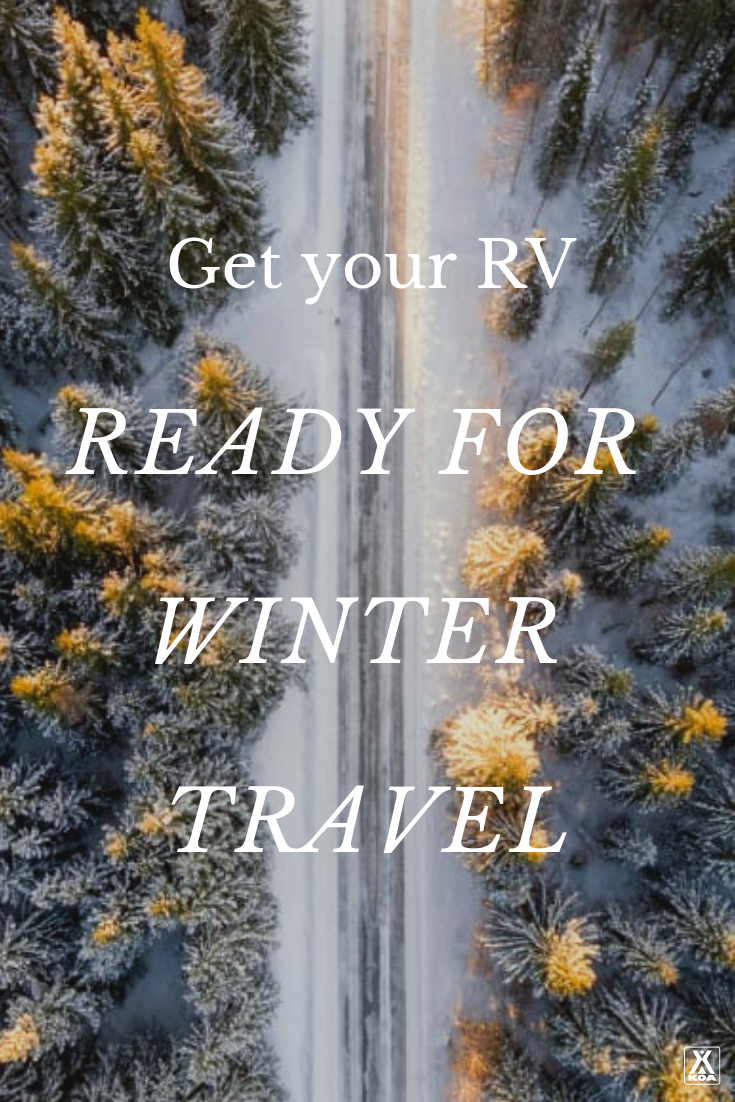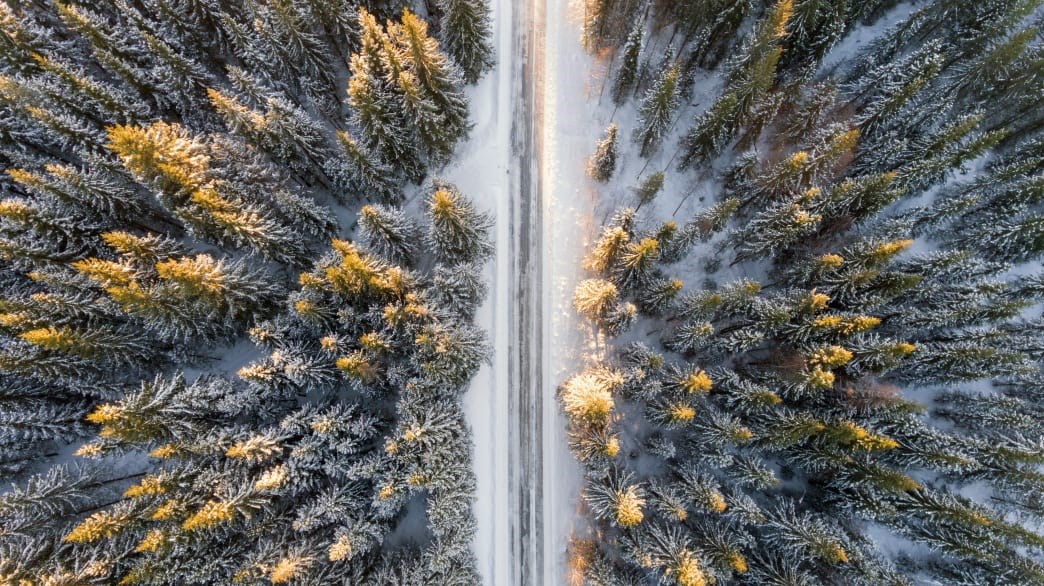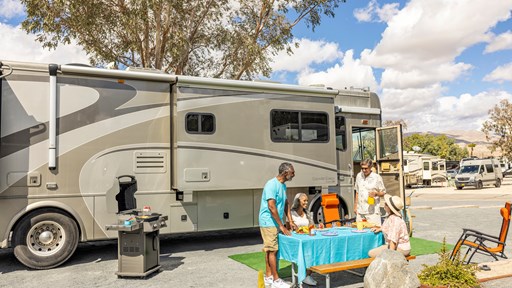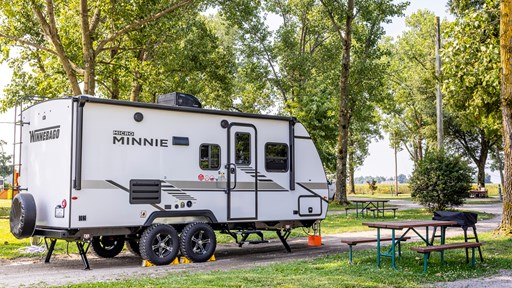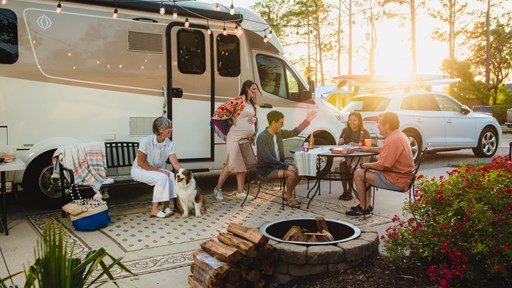Just because the temperatures start to drop doesn’t mean you have to put your camping rig in storage. Campsites are quieter and views are snowy—it’s a wonderful time to cozy up in nature. And with a little preparation, you’ll find that winter camping is easier than you might think. Let’s take a look at what you need to do to get your RV winter-ready.
1. Seal Her Up
Before heading out on a winter adventure, thoroughly examine the caulking on your rig. Pay particular attention around windows, paneling, edges, and corners. If you notice that caulking is cracking, detaching, or non-existent, it’s time to reapply.
Before you begin, cut out all old caulking using a utility knife. Pull all loose strands and clumps from the old caulked area. Next, clean the area with rubbing alcohol and a cloth. For caulking, use either an RV-specific caulking or a silicone-based caulk to ensure that the caulk can handle the bumps and movement while on the road. Create a consistent, slightly indented bead and wait several days for the caulk to fully dry before hitting the road.
2. Be Snug as a Bug
The key to a comfortable winter season is a properly insulated vehicle. However, most RVs don’t come fully winterized. Non-insulated windows suck precious heat from your RV. The most expensive fix is to retrofit insulated windows into your rig.
The DIY option is to fashion some insulated covers to velcro over windows. Head to a hardware store and pick up a few rolls of reflective, bubble insulation and some velcro (the amount will depend on how many windows you have).
Measure each window and cut out sheets of the bubble insulation. Be sure to add enough width to account for the velcro, plus around a half-inch extra to give you some wiggle room. You can either install the velcro now or cut another sheet the exact size of the window to double up. If you double up, use adhesive to attach the two pieces of insulation, centering the smaller shape into the bigger one. Add velcro and voila! You now have custom-fit insulation you can place on windows during the night to keep the heat in. For ceiling vents, you can purchase vent cushions to protect you from the cold.
Lastly, check to see if the underside of your travel trailer is insulated. You can install hard-foam insulation underneath your rig, although this only feasible if you are using a travel trailer that doesn’t have engine parts to navigate.
3. Water, Water Everywhere

In the winter, water systems are susceptible to freezing. If you have a water system installed in your RV or travel trailer you’ll want to take a few extra steps before Jack Frost comes to visit.
First, empty your black water tank before setting out and immediately upon returning home. No one wants an iced-over black water tank. Consider not using the tank at all if you’re camping near bathrooms.
Prior to heading out, wrap your sewer hose and fresh water line with insulative plumbing tape or foam insulation. Always keep hoses off the ground (especially those that are tied into a water hookup). Alternatively, you can purchase a heated water hose. Disconnect the hose and let it drain completely after you fill up your freshwater tank. Be sure to drain the tank once you get back.
If temperatures drop to 20 degrees or below, the gas in your refrigerator can turn to gel. This process is irreversible and permanently ruins the fridge. Combat this by removing the outside fridge access cover and apply duct tape over the top two vent slots. You can also insert half-inch pipe insulation on the top two slots from the exterior. If temps really plummet, consider putting a small space heater in the compartment. Take care to set the heater to low and keep it away from flammable surfaces. Some small fridges are easy to remove, and that may be your best bet for winter. Use a cooler instead, you won’t need much ice with the chilly temps.
4. Keep Warm
Now that your RV is winter-road ready, let’s get that winter ambiance going. Pack plenty of layers so you can stay toasty when you want to spend time outdoors. In the evenings, keep the logs on your fire close together and the coals closer to create a toasty coal bed. Bring s’mores, sip a warm beverage, and get close to the heat.
For bedding, down offers the best insulation. Bring extra blankets and use down sleeping bags unzipped on top of comforters for added warmth. Get in touch with the child in you and create the ultimate blanket fort—it’s all about feeling cozy.
If you do have a heater (portable or otherwise), be sure that the carbon monoxide detector is up to snuff. Always crack a vent open so air can circulate throughout the night (this also helps with condensation build-up). Clean your furnace before first use. Don’t have a heater? Run your vehicle on frigid mornings, bonus points if you have seat heaters.
Pro tip: Keep your phone and any camera batteries under the covers with you to keep them from dying in the cold overnight.
5. Be Prepared

It’s essential to ensure that your vehicle and engine are working properly. Ensure you have proper tires on both your rig and vehicle. Carry chains and install an engine block heater if you’re in extreme climates. Always carry extra snacks, water, and a fire-starting kit just in case you hit trouble on the road.
When you pull up to your site, pay attention to the wind (a real mood killer in winter). You don’t want blowing snow building up against your vehicle or rig. Position your trailer so the short end is facing into the prevailing wind. In a pinch, use your vehicle as a wind block between your trailer and front door.
6. Do Your Homework
Many campsites and roads are closed during the winter, but many KOAs across the United States are open year round. Be sure to check often for local road conditions, weather, and other important info. Keep the local sheriff’s number on your phone in case you run into trouble on the road.
In the winter, you’ll want a few extra safety items to help out in case of trouble, such as:
- Extra food
- Extra water stored in a warm area
- A white gas stove (propane can freeze in the winter)
- A blow dryer to defrost pipes/tanks
- Extra blankets, socks, and base layers
- Gas-powered generator (for larger rigs)
- Shovel
- Kitty litter (put under your tires for traction if you get stuck in the snow)
Now that you’re winter-ready, it’s time to experience the fourth season of the great outdoors. Get ready for twinkling snow, warm fires, and comfy nights.
Written by Meg Atteberry for RootsRated Media in partnership with Kampgrounds of America.
